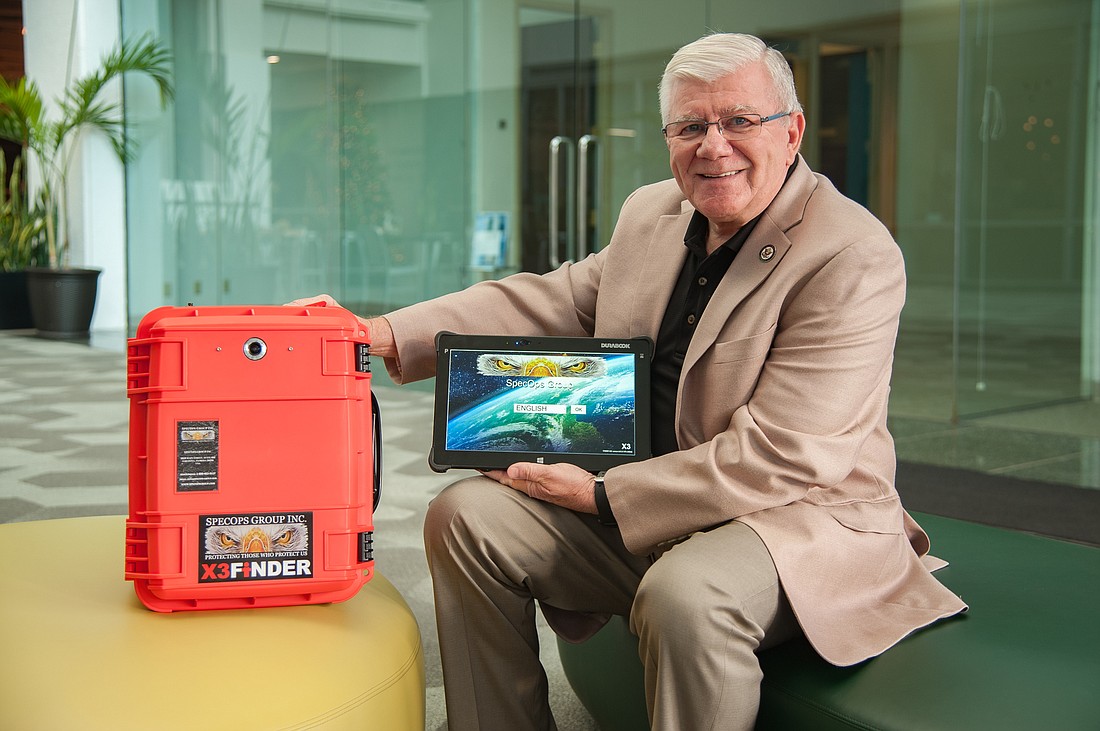- July 26, 2024
-
-
Loading

Loading

The police get a 911 call. There’s a domestic violence situation. They arrive on the scene. Looking at the house from the outside, there’s no way to know who is inside — who might pose a threat and who might be in danger.
Sarasota-based SpecOps Group Inc. has a solution for that.
It’s developed a product called the X3Finder that detects heartbeats and respiration using microwave radar technology. Results show up on a tablet-like device, revealing information after approximately 60 seconds about how many men, women and children were detected inside a structure.
SpecOps Group President and CEO Adrian Garulay says the company has other products — a whole catalog full — but it decided to focus on the X3Finder and a smaller, yet-to-be-released version of the product in the latter stages of development. The goal? Seize on the device’s uniqueness and sales potential. And with the smaller X3Finder, a less expensive version with similar capabilities dubbed Life Hunter — the company executed on a staple of business, and military, excellence: the ability to nimbly adapt to the marketplace.
“It’s big because it’s small.” — Adrian Garulay, president and CEO, SpecOps Group
Now, after years of development, Garulay sees 2019 as a growth year and a chance to recoup some of the $2 million invested in the X3Finder. While declining to disclose revenue figures, Garulay projects SpecOps will sell 1,200 units of the X3Finder and 5,000 units of the Life Hunter, bringing in $7 million to $10 million in sales over the next year and a half. “We have other products in the pipeline, but the plan is to focus on these for now,” he says.
The company is also seeking more investors, aiming to raise an additional $5 million to further SpecOps’ mission and develop more technology.
Garulay, who used to work in naval intelligence, started SpecOps in 2014 with co-founder Tom Coulter, a retired U.S. Navy SEALs commander.
Garulay says X3Finder’s origins, meanwhile, lie in the Department of Homeland Security asking NASA if it could develop a search-and-rescue device. NASA already had an idea, he says, based on the medical monitoring of people in space. SpecOps worked in tandem with NASA to develop a commercial product around it. “We took it to a different level,” Garulay says, seeing the potential for other applications. “What really makes this work is software,” he says, which was developed by SpecOps electrical engineers.
The X3Finder can be used after earthquakes, tornados, hurricanes, avalanches, wildfires, bridge collapses of other disaster scenarios. The device, which allows people to see through an 18-inch thick solid concrete wall, also has anti-terrorism, immigration and human trafficking prevention uses.
The varied applications means the company’s list of potential clients is long. It includes search-and-rescue teams, law enforcement, fire departments, military, SWAT teams, the Federal Emergency Management Agency and Customs and Border Protection.
So far, the company has sold more units overseas than in the U.S. A domestic challenge, Garulay says, is the longer budget cycles of federal and state agencies. But while the wait can be long before products are incorporated into a government budget, the flip side, he says, is those agencies and departments usually order big quantities.
Overseas, a large market for SpecOps is the Ring of Fire region around the Pacific Ocean where earthquake and volcano activity is more common.
From its world headquarters in Sarasota, SpecOps operates around the globe in countries including Jordan and Singapore. In the U.S., it has nine employees, with two each in Singapore and Jordan. Elsewhere in the world, SpecOps uses sales representatives and distributors to sell products.
SpecOps isn’t ignoring its stateside market. “We really want to ramp up our sales in the U.S.,” Garulay says, pointing to Life Hunter and the obvious cost difference between it and the X3Finder: $17,000 for the X3Finder, while the Life Hunter, attachable to weapons, is priced at $1,500.
Garulay says Life Hunter will appeal to members of the military, firefighters and law enforcement. It will also be available for civilians, including hunters detecting animals and people detecting potential home intruders. The new product will be available in a month. “It’s big because it’s small,” he says.
SpecOps started marketing the X3Finder about a year and a half ago. The product, manufactured in Tampa, has been available in the retail market for about nine months.
Primarily customers are aware of it through trade shows SpecOps attends that are focused on defense and security, Garulay says. Company officials have gone to shows worldwide, and it's spreading by word of mouth. “That’s how it proliferates,” Garulay says.